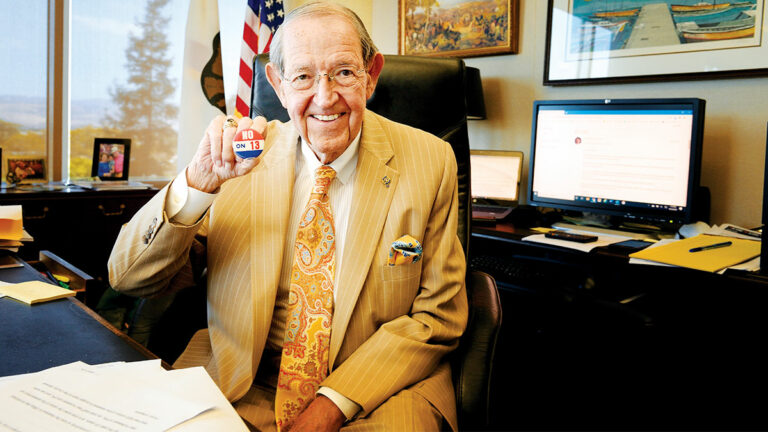Whether Proposition 15 will prevail at the ballot next month is anyone’s guess, but the measure to amend a key state law governing how property is taxed and money distributed is the closest anyone has come to changing what is known as the “third rail” of California politics—despite nearly 40 years of attempts.
The current state law, known as Proposition 13, was dubbed the “keep grandma in her house” initiative when it passed in 1978, because it all but froze property tax assessments at the moment of purchase, allowing for small annual tax increases, ensuring that people—particularly those on fixed incomes—wouldn’t get taxed out of their homes as property values soared. That’s what made the law so untouchable.
But Prop. 13 also applies to other kinds of properties, including towering office buildings and pastoral golf courses. Prop. 15 would change that by mandating that commercial properties be assessed every three years and taxed at their current fair market value. The proposition, known as “Schools and Communities First,” would not change how residential property—single-family houses, condos and apartment buildings—is assessed.
But some critics, including Prop. 13 reform proponents, say that Prop. 15 contains a hidden disparity for the Bay Area: It would ship Silicon Valley money out of the region. And progressive voters who may be inclined to support Prop. 15 because they believe in property tax reform may not know that’s what they are voting for, says Jennifer Bestor, the volunteer research director for nonprofit Educate Our State.
“If you understand property tax allocation—and this [measure] came out of L.A., and those folks do—the way that it all falls out is actually they [Los Angeles] end up also being the biggest taker from the statewide school pot,” says Bestor, who was speaking on behalf of herself and not Educate Our State. “This whole thing is meant to extract money up here and ship it down there.”
Advocates for Prop. 15, known as Schools and Community First, say it’s not that simple.
While money will move between counties and across the state if the measure is approved, the distribution is meant to send money to the neediest schools and equalize education across California, which ranks 41st in the country when it comes to K-12 spending per student after adjusting for the cost of living, according to the California Budget and Policy Center.
“The state, especially Silicon Valley, has created incredible wealth, and every single school in the state will benefit,” says Alex Stack, communications director for the Schools and Community First campaign. “We are fine with ESL [English as a second language] learners and foster kids and low-income students getting a bit more resources to address.”
Stack says that with Prop. 15, each school will be guaranteed at least $100 more per child annually than they are guaranteed today, marking a win for schools across the state.
But Bestor says that after crunching the numbers, she’s not convinced that parents and school districts in the Bay Area will feel the proposition is a win.
“When people feel like they’re spending so much on the schools … and then it doesn’t get there, it ruins our civic faith in our schools,” she says.
The proposition promises to bring somewhere between $6.5 billion and $11.5 billion to schools, community colleges and local governments in the coming years as properties are reassessed.
A “slim majority” of residents in the state are leaning toward a yes vote on Prop. 15, according to mid-September polling by the Public Policy Institute of California.
Of the money that would be raised by the passage of Prop. 15, about $1.2 billion of it would come from Santa Clara County, the second-biggest revenue generator next to Los Angeles County, according to a study by the University of Southern California. Another $57.5 million would be generated in Santa Cruz County, the study estimates.
While 40% of the taxes would go to schools across the state, 60% would go to other local government efforts, like infrastructure, fire safety, homelessness efforts and more.
But according to Bestor’s calculations, counties like Santa Clara, San Mateo and San Francisco, with their many tech titans, would contribute hundreds of millions of dollars in property taxes that would end up in other counties.
While several advocates for the measure said in interviews that they didn’t know that not all of the money raised in the county would stay put—showing that Bestor’s concern may not be unfounded—each maintained that they still supported the measure.
Walter Wilson, a principal at the Minority Business Consortium, has been a major supporter of the measure, but this week said he didn’t know that the money wouldn’t all stay in Silicon Valley. Even so, he says opponents have not shown that the measure will negatively impact businesses or communities, and he wants companies to pitch in “their fair share.”
“The whole idea is that this is not the time to raise taxes on taxpayers, but this is the time to raise corporate taxes on corporations that have been getting away, for … 40 years, with billions of dollars in taxes that should have gone back to our communities and schools,” Wilson says.
Big Bucks
Indeed, the promise of new funding for those institutions comes as a pandemic-induced recession creates deficits for cities across the state and schools try to adapt to distance learning with shrinking budgets.
Even critics of the measure acknowledge that’s likely to make the proposition look even more appealing to some.
“I think there’s going to be some real pressure on local governments that are seeing their property tax and their sales tax not come in this fiscal year and be dramatically reduced to push for that (measure) as a backfill,” former Assemblywoman Catharine Baker, who is a special counsel at San Jose law firm Hoge Fenton and doesn’t personally support Prop. 15, said during a real estate panel in April.
Advocates estimate that about 90% of the money generated by Prop. 15 would be paid by 10% of the state’s largest companies, including Chevron and Disney. In the Bay Area, some of Silicon Valley’s biggest tech titans would likely find themselves with a larger tax bill than they’re used to under Prop. 15.
Santa Clara-based Intel, for instance, has owned its Santa Clara campus since the 1980s, meaning its tax rate is only marginally higher than where it was initially set, despite the gains in land value throughout the region. But that’s not the only commercial property owner benefitting from Prop. 13, according to the 2019 Santa Clara County tax roll.
About 24% of office, retail and industrial buildings in Santa Clara County were purchased before 1989, but they make up 15% of the total assessed value on those types of properties. Meanwhile, the 44% of commercial properties purchased after 2008 make up 61% of the assessed value for such properties across the county.
Advocates say the measure also takes great pains to consider small businesses.
Prop. 15 includes an exemption for land owners with a property portfolio across the state valued at less than $3 million. It also cuts the personal property tax, or the assessment for all of the stuff inside of a building, for companies that own equipment worth less than $500,000. Small businesses, or companies with 50 or fewer employees, won’t pay the personal property tax anymore.
If the majority of a property is leased to small businesses, that building won’t be reassessed until 2025, allowing a grace period before those leases would be impacted by rising costs.
“The phase-in is very important, because we’re not talking about small businesses that will be affected at the time when they could least afford it,” Stack says.
The Legacy of Prop. 13
Previous efforts to amend Proposition 13 have failed to gain momentum in large part because, as in national politics today, the two sides of the argument don’t seem to agree on the basic facts.
On one end of the spectrum, advocates say Proposition 13 is broken, arguing that it creates severe inequity across the state for all property owners, exacerbates the housing crisis and contributes to the under-funding of local school systems.
From that position, the only option is to analyze the best fix—and fast.
But on the other side of the issue are those who say that Proposition 13 is not only not broken, but doing exactly what it is supposed to do: create consistency for government budget planning, allow all property owners to make investments with certainty and encourage businesses to stay in California.
In other words, if it isn’t broken, don’t fix it.
“It’s good for everybody to know what your taxes are going to be when you buy property,” says Susan Shelley, vice president of communications for the Howard Jarvis Taxpayers Association. “It’s true that people who bought many years ago have a lower tax assessment than their neighbors may, but everybody who buys has the certainty that they will not be taxed unexpectedly out of their property.”
When it comes to Prop. 15 as a means to change the current property tax law, critics of the ballot measure say it is flawed because even if major corporations do pay most of the Prop. 15 tab, no one in the state—including residents—will escape the ripple effects of increased taxes for property owners.
For instance, most small business owners have leases that are written in a way that would absorb new property tax costs, known as a “triple net” lease. That means even if the property owner is a large corporation, their renters could be the ones to pay for the increased taxes. Higher rent may mean costlier goods at local shops, or worse.
“You just took their very narrow margins that they are operating on already and you made those even smaller,” Edwin Lombard, president and CEO of the California Black Chamber of Commerce, said in a recent Hoge Fenton-hosted panel. “In many cases, these businesses are not going to be able to exist and will be forced to close their doors.”
Opponents also say the pandemic and resulting economic fallout is a major reason residents should be wary of a measure that increases business taxes.
Wilson, of the Minority Business Consortium, is quick to push back on that. He doesn’t believe property tax increases for some landowners will have trickle-down impacts to small businesses. Instead, the market will find equilibrium as small businesses look for good deals in their leases, he says.
Indeed, local government and school budget shortfalls due to the pandemic are being held up as a reason to pass Prop. 15 by those in favor of the measure.
At the beginning of the year, “California’s economy was doing very well … but the thing that really is holding it back is persistent poverty, homelessness, and inequity in the state,” Stack says. “A lot has happened since January, and those issues have only gotten more dire.”
Feasibility Study
But another unlikely opponent of the measure is Santa Clara County Assessor Larry Stone.
Stone has never been on the popular side of the debate over Proposition 13, though he’s the one who has been enforcing the law for the past 26 years.
When Prop. 13 passed in the ’70s, the then-Sunnyvale councilman was staunchly against it, and he has the 42-year-old button urging residents to vote “No on 13” to prove it. But residents anxious about rising property values were unconvinced.
Prop. 13 allows for property in the state to be taxed at about 1% of its value, and for a 2% increase in property value annually. Stone acknowledges it did serve its critical purpose: It stopped Californians—particularly those on fixed incomes—from being taxed out of their homes. But he says its flaws are all too apparent four decades later.
“On the residential side, that was very legitimate,” Stone says. “The way they treated it by installing a 1% tax rate universally, forever, has created just this tremendous disparity today. … You could not create a more unfair property tax system than we have in California.”
Stone has advocated openly for Prop. 13 reform—a brave or foolhardy move, depending on who one asks—as the law quickly became the proverbial “third rail” of California politics. For most politicians, touching Prop. 13, the bill the saved California’s grandmas, has been considered career suicide—until now.
In the midst of the 2020 chaos—a contentious presidential election year, a growing housing crisis, a devastating pandemic dragging down a previously booming economy, and an unprecedented West Coast wildfire season that has covered communities in ash—this is the year Californians seem most willing to consider a change, even to laws that were once untouchable.
Some politicians who may not have dared to touch the issue before are also throwing their weight behind the idea, but ironically not the one most thought would jump on board with such a reform: Larry Stone. The longtime Prop. 13 opponent says the measure would not be hard but “impossible” to implement.
“They’re trying to fix, with this one convoluted ballot measure, 42 years of inequity,” he says. “You can’t do it, and do it fairly.”
Forging Ahead
The arguments for and against Proposition 15 are nuanced and rely on a bit of guesswork about what will happen if the measure is passed.
But all of those arguments are moot for Stone and the California Assessors Association (CAA), which in June came out against the measure. The association commissioned a study that estimates the proposition would cost more than $1 billion to implement before any revenue rolls in and says the law would be extraordinarily challenging to put to work.
Stone and the CAA question whether counties can staff up fast enough to do the assessments that would be required by law and tackle an inevitable influx of appeals that would follow. They also note how challenging it would be to track property values and employee counts across the state as required, and say that some counties—particularly rural ones—may lose tax revenue as a result of the measure.
Even so, if voters want Prop. 15, they’ll do their best, the association says.
“The assessors of California are committed to fair and impartial implementation of the Constitution and the laws of the State of California, and, as always, assessors will faithfully
implement the will of the people,” the letter states.
Advocates for the measure say they’ve taken into account those concerns by redoing the ballot language to lengthen the time frame assessors will have to reassess properties. They maintain implementing the law will be possible and profitable.
“That’s why we refiled [the measure], and we made sure to do that for a longer period of time and not require that [it] even has to be fully implemented until 2026,” Stack says. “I could get into the details of this stuff, but at the end of the day, this is how the rest of the country does it.”
Not every assessor feels as passionately as Stone. Stephen Vagnini, Monterey County’s assessor, acknowledges the challenges of the bill, but says his office is prepared either way.
“There’s obviously some flaws in the language, which makes it very difficult and … the big challenge that everyone says is, ‘We don’t have enough commercial appraisers to do the work,’” he says. “But if the voters tell us to do it, we have to do it, and personally, I don’t take positions on initiatives.”
Vagnini says he knows assessors who are preparing under the assumption that the proposition will pass, while others have barely given it a thought because they are sure it will fail.
After all of the votes are tallied, those assessors will know whether the state will reforge that political third rail into something different, a new form advocates might call elegant—and critics call fragile.
Proponents of the initiative include Working Partnerships USA, the Chan Zuckerberg Initiative, SOMOS Mayfair, California Teachers Association, SIREN and the League of Women Voters.
Opponents of Prop. 15 include the California Business Roundtable, California Taxpayers Association, California Chamber of Commerce, and the primary driver for the initial 1978 property tax law: the Howard Jarvis Taxpayers Association.
Regardless of sides, one of the most daunting questions for both sides of the issue is around the unprecedented momentum of the movement to change Prop. 13 today.
Some Prop. 15 opponents say the measure should be shelved so the conversation can continue later, when small businesses aren’t already struggling and buckling under the weight of a pandemic.
But those who think Prop. 13 needs reform—including Stone—say losing momentum during a critical year when voters are expected to turn out is a devastating prospect.
“The sad thing is that if this goes down and this fails, politically it’s going to be a while before something more realistic can happen,” Stone says. “That’s the problem with Proposition 13, is that they put it in the California Constitution, so every time you try to change something, you’ve got to go to the ballot.”
Click here to see all of our ongoing 2020 election coverage.
























